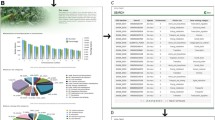Abstract
Intron length polymorphisms (ILPs) are a new kind of molecular markers, which can be detected by PCR with specific primers designed on exons flanking the target introns. In this study, we identified 2300 putative introns and successfully designed primers for them in loblolly pine by comparing the cDNAs of loblolly pine with the homologous genes of Arabidopsis and rice, and experimentally examined 400 of them using 9 conifer species of two families (7 of Pinaceae and 2 of Cupressaceae) as materials. We found that about 88% of the predicted introns appeared to be correct, suggesting that the exon–intron structures are highly conservative in plants, even between Magnoliophyta and Coniferophyta. Therefore, prediction of introns in the species of Coniferophyta by referring to the model species of Magnoliophyta is feasible. Based on 39 ILP markers, a reasonable dendrogram of the 9 conifer species was constructed, demonstrating that ILP markers are quite suitable for phylogenetic studies involving distant species or higher taxonomic ranks.


Similar content being viewed by others
References
Altschul SF, Madden TL, Schäffer AA, Zhang J, Zhang Z, Miller W, Lipman DJ (1997) Gapped BLAST and PSI-BLAST: a new generation of protein database search programs. Nucleic Acids Res 25:3389–3402
Becker J, Heun M (1995) Barley microsatellites: allele variation and mapping. Plant Mol Biol 27:835–845. doi:10.1007/BF00020238
Bierne N, Lehnert SA, Bedier E, Bonhomme F, Moore SS (2000) Screening for intron-length polymorphisms in penaeid shrimps using exon-primed intron-crossing (EPIC)-PCR. Mol Ecol 9:233–235. doi:10.1046/j.1365-294x.2000.00842.x
Botstein D, White RL, Skolnick M, Davis RW (1980) Construction of a genetic linkage map in man using restriction fragment length polymorphisms. Am J Hum Genet 32:314–318
Choi HK, Kim D, Uhm T, Limpens E, Lim H, Mun JH, Kalo P, Penmetsa RV, Seres A, Kulikova O, Roe BA, Bisseling T, Kiss GB, Cook DR (2004) A sequence-based genetic map of Medicago truncatula and comparison of marker colinearity with M. sativa. Genetics 16:1463–1502
Deutsch M, Long M (1999) Intron-exon structures of eukaryotic model organisms. Nucleic Acids Res 27:3219–3228
Farjon A (1998) World checklist and bibliography of conifers. Royal Botanic Gardens, Kew, England
Florea L, Hartzell G, Zhang Z, Rubin GM, Miller W (1998) A computer program for aligning a cDNA sequence with a genomic DNA sequence. Genome Res 8:967–974. doi:10.1101/gr.8.9.967
Hampl V, Pavlicek A, Flegr J (2001) Construction and bootstrap analysis of DNA fingerprinting-based phylogenetic trees with the freeware program FreeTree: application to trichomonad parasites. Int J Syst Evol Microbiol 51:731–735
Hawkins JD (1988) A survey on intron and exon lengths. Nucleic Acids Res 16:9893–9908
Joshi S, Ranjekar P, Gupta V (1999) Molecular markers in plant genome analysis. Curr Sci 77:230–240
Kirst M, Johnson AF, Baucom C, Ulrich E, Hubbard K, Staggs R, Paule C, Retzel E, Whetten R, Sederoff R (2003) Apparent homology of expressed genes from wood-forming tissues of loblolly pine (Pinus taeda L.) with Arabidopsis thaliana. Proc Natl Acad Sci USA 100(12):7383–7388
Kruglyak L (1997) The use of a genetic map of biallelic markers in linkage studies. Nat Genet 17:21–24
Mohan M, Nair S, Bhagwat A, Krishna TG, Yano M, Bhatia CR, Sasaki T (1997) Genome mapping, molecular markers and marker-assisted selection in crop plants. Mol Breed 3:87–103. doi:10.1023/A:1009651919792
Mosseler A, Egger KN, Hughes GA (1992) Low levels of genetic diversity in red pine confirmed by random amplified polymorphic DNA markers. Can J For Res 22:1332–1337. doi:10.1139/x92-177
Murray MG, Thompson WF (1980) Rapid isolation of high-molecular- weight plant DNA. Nucleic Acids Res 8:4321–4325
Nei M (1978) Estimation of average heterozygosity and genetic distance from a small number of individuals. Genetics 89:583–590
Nkongolo KK, Michael P, Gratton WS (2002) Identification and characterization of RAPD markers inferring genetic relationships among pine species. Genome 45:51–58. doi:10.1139/g01-121
Peleman JD, van der Voort JR (2003) Breeding by design. Trends Plant Sci 8:330–334
Roy SW, Penny D (2007) Patterns of intron loss and gain in plants: intron loss-dominated evolution and genome-wide comparison of O. sativa and A. thaliana. Mol Biol Evol 24:171–181. doi:10.1093/molbev/msl159
Rozen S, Skaletsky H (2000) Primer3 on the WWW for general users and for biologist programmers. Methods Mol Biol 132:365–386. doi:10.1385/1-59259-192-2:365
Schuler GD (1997) Sequence mapping by electronic PCR. Genome Res 7:541–550. doi:10.1101/gr.7.5.541
USDA, ARS, National Genetic Resources Program (2010) Germplasm resources information network—(GRIN) [Online Database]. National Germplasm Resources Laboratory, Beltsville, Maryland. URL: http://www.ars-grin.gov/cgi-bin/npgs/html/taxgenform.pl. Accessed 25 October 2010
Vos P, Hogers R, Bleeker M, Reijans M, van de Lee T, Hornes M, Frijters A, Pot J, Peleman J, Kuiper M (1995) AFLP: a new technique for DNA fingerprinting. Nucleic Acids Res 23:4407–4414
Wang X, Zhao X, Zhu J, Wu W (2005) Genome-wide investigation of intron length polymorphisms and their potential as molecular markers in rice (Oryza sativa L.). DNA Res 12:417–427. doi:10.1093/dnares/dsi019
Wendel JF, Cronn RC, Alvarez I, Liu B, Small RL, Senchina DS (2002) Intron size and genome size in plants. Mol Biol Evol 19:2346–2352
Williams CG, Neale DB (1992) Conifer wood quality and marker-aided selection: a case study. Can J For Res 22:1011–1019. doi:10.1139/x92-135
Williams J, Kubelik A, Livak K, Rafalski J, Tingey S (1990) DNA polymorphisms amplified by arbitrary primers are useful as genetic markers. Nucleic Acids Res 18:6531–6535
Xu S, Tao Y, Yang Z, Chu J (2002) A simple and rapid methods used for silver staining and gel preservation. Hereditas (Beijing) 24:335–336
Yang L, Jin G, Zhao X, Zheng Y, Xu Z, Wu W (2007) PIP: a database of potential intron polymorphism markers. Bioinformatics 23:2174–2177. doi:10.1093/bioinformatics/btm296
Acknowledgments
This work was funded by the National Natural Science Foundation of China (Grant No.: 30771750) and the National Hi-Tech Research and Development Program (863 Program) of China (Grant No.: 2006AA10Z1E2).
Author information
Authors and Affiliations
Corresponding author
Electronic supplementary material
Below is the link to the electronic supplementary material.
Rights and permissions
About this article
Cite this article
Chen, X., Zhang, G. & Wu, W. Investigation and utilization of intron length polymorphisms in conifers. New Forests 41, 379–388 (2011). https://doi.org/10.1007/s11056-010-9229-5
Received:
Accepted:
Published:
Issue Date:
DOI: https://doi.org/10.1007/s11056-010-9229-5




